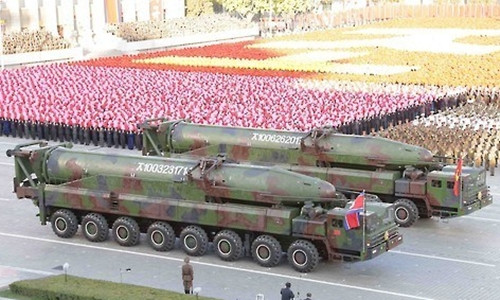North Korea - America's growing threat of destruction
Experts fear that in the next four years, North Korea's nuclear-tipped missiles could reach the US capital Washington and New York City.
 |
North Korea's KN-08 missile. Photo: Yonhap. |
North Korea's fifth nuclear test on September 9 was considered very worrying because it demonstrated Pyongyang's progress in mastering atomic weapons manufacturing technology, especially in the program of developing nuclear-tipped missiles that could threaten most of the US territory, according to the New York Times.
Analysts and US military officials say North Korea is rapidly moving toward its goal of producing a small, fast, light nuclear missile capable of surprise attacks, and has had some successful tests in 2016.
"North Korea's testing pace has increased significantly. It appears they are deliberately showing off their capabilities by showing us nuclear test sites that they could otherwise hide. This is something we cannot take lightly and will be a top priority for the next US president," said John Schilling, an expert on North Korea's missile program.
Military experts believe that by 2020, Pyongyang could have the technology needed to produce a reliable intercontinental ballistic missile that can carry a nuclear warhead. They also predict that by then, North Korea could have accumulated enough nuclear material to produce 100 warheads.
A Pentagon report earlier this year warned the US Congress that one of Pyongyang's latest missiles, if completed, "would be able to reach much of the continental United States".
Jeffrey Lewis, a North Korea expert at the Middlebury Institute of International Studies in Monterey, California, said recent tests suggest North Korea may have very powerful rocket engines.
"That means that North Korea's intercontinental ballistic missiles can not only reach the West Coast, but can also strike targets across the United States, including Washington DC," expert Lewis affirmed.
According to commentator William J. Broad, when President Barack Obama took office in January 2009, Pyongyang had deployed hundreds of short- and medium-range missiles using engines that imitated Russian designs, and had exported hundreds of weapons equipped with conventional warheads to countries such as Egypt, Iran and Syria.
North Korea was also developing a new missile with a much more advanced engine. Western intelligence analysts were stunned to discover that the new engine was derived from the R-27, a compact nuclear-tipped missile that was carried by Soviet nuclear submarines.
This type of engine was later developed for the Musudan missile, giving it a longer range thanks to its powerful thrust. Analysts warn that the Musudan's warhead can fly as far as 4,320 km, enough to reach the US base in Guam, but not yet reaching intercontinental range.minimumis 6,120 km.
At a parade in late 2010, Pyongyang first displayed a missile powered by the R-27 engine.North Korea also uses two R-27 engines to power the KN-08 missile, which has intercontinental range and can launch a warhead to the West Coast of the United States.
The KN-14 missile, a longer-range version of the KN-08, could theoretically deliver Pyongyang's nuclear warhead as far as Washington, DC.
The KN-08 and KN-14 are considered by military analysts to be the most dangerous missiles in North Korea's arsenal, especially after a test in April showed that the engines of these two missiles are very powerful.
However, experts also say it will take several more years for North Korea to be able to deploy a reliable long-range missile, because Pyongyang has not yet mastered the complex technology needed to prevent a nuclear warhead from burning up due to the heat it generates when plunging from space to its target.
"The likelihood that North Korea will be able to successfully produce a missile with a range that can reach most of the United States is low. However, we assess that probability as low as it is increasing, and the United States needs to invest to improve its defenses against the threat of a North Korean nuclear attack," William E. Gortney, head of the North American Aerospace Defense Command, warned.
According to VNE
| RELATED NEWS |
|---|

